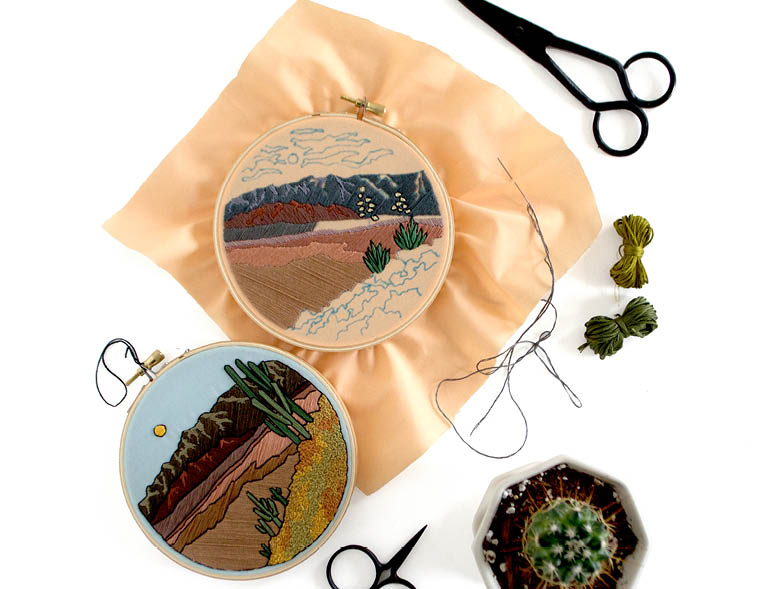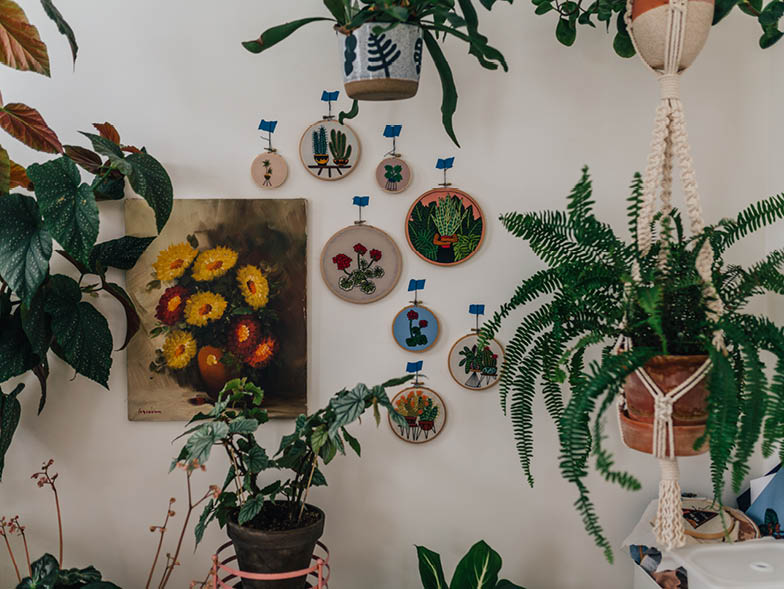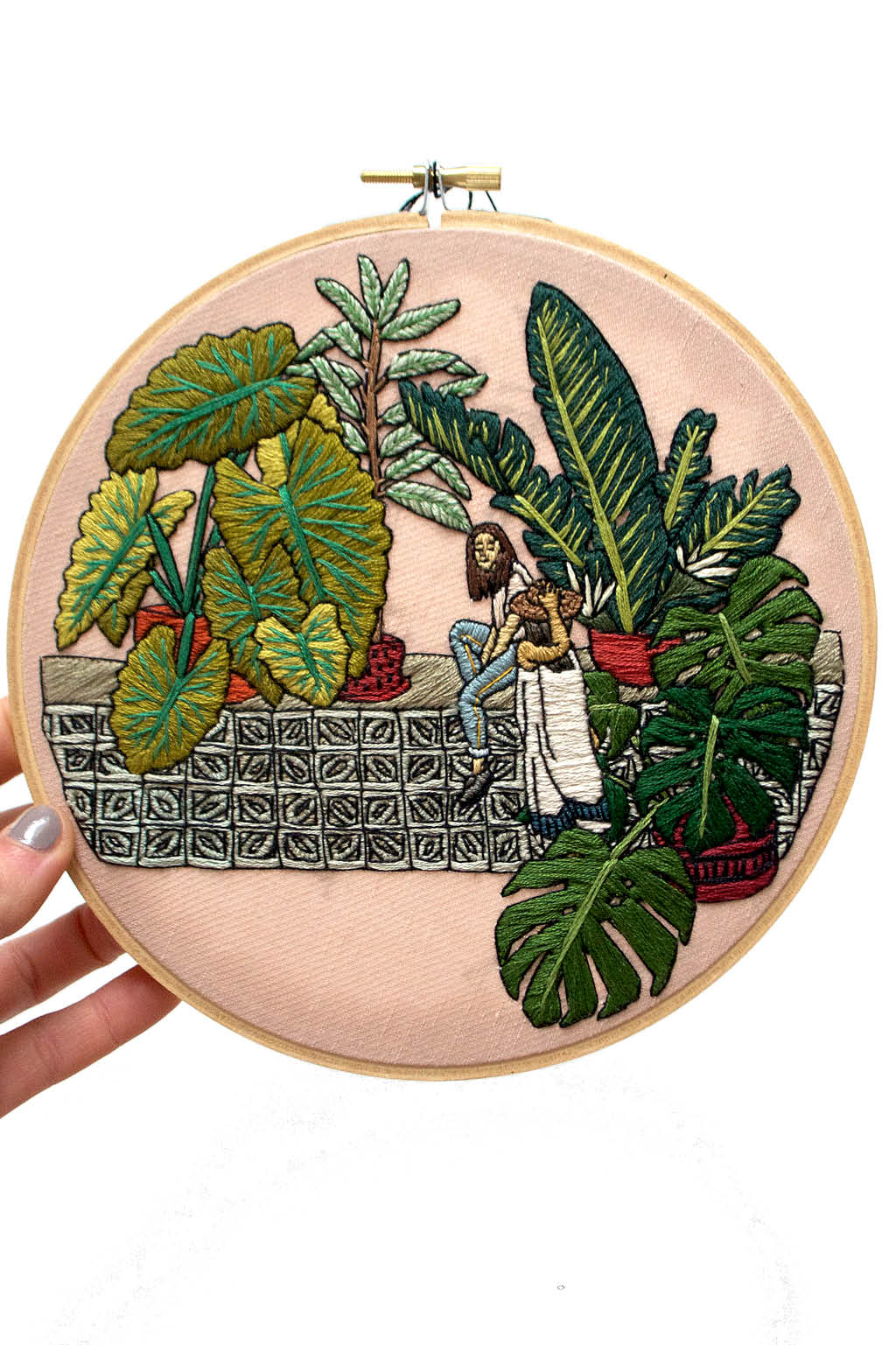Succulents And Stitches
New Hampshire-based fiber artist Sarah K. Benning began dabbling in embroidery as a nighttime hobby postcollege while she was nannying. Her hobby quickly turned into a full-time career, which now includes selling pieces, prints, cards, and kits on her website, traveling to teach workshops, and selling artwork at craft fairs and pop-ups.
What was it like growing up in Baltimore? Were you always drawn to art?
I loved growing up in Baltimore. My mom and I moved to a neighborhood called Lauraville when I was seven. The neighborhood itself, and Baltimore at large, is full of creative energy, art, music, and culture, and I think it had a profound impact on me. We had lots of friends that worked as artists, so the idea that it was possible to have art as a career was never disputed. My mom was also fully supportive, and we lived in an area that had helpful resources, like TWIGS, a free after-school arts program at the Baltimore School for the Arts.
What did your academic path look like?
I give a lot of credit to my high school, the Baltimore School for the Arts. The curriculum is highly structured and focuses on the foundational skills of creating art—concept is almost secondary—and I am grateful for the skills and work ethic I developed there.
After high school, I attended the School of the Art Institute of Chicago for my BFA because the curriculum was designed almost entirely around concept—a completely opposite experience of BSA. I spent most of my time in the arts administration and fiber arts departments.
Would you elaborate on how you discovered embroidery?
I started making hand-stitched greeting cards for fun, which evolved into embroidery on fabric. At the time, embroidery felt like a safe medium to explore and play with, without any pressure to make something serious that could be considered art. It was craft in my mind, and it provided a way to be creative and keep my hands busy, but I also didn’t have to (or want to) identify as an artist at the time. Since then, I have reconciled the line between art and craft, and hobby and business and studio practice, and very much consider what I do and create to be artwork.

Where do you find yourself most often looking for inspiration?
Most of my work is based in botanical and interior imagery, and I look to my own home and collection of houseplants for inspiration first. I have always been interested in the significance of personal objects and spaces, so looking to my immediate surroundings to create compositions makes sense to me. I also have the opportunity to travel quite a bit for work—teaching workshops and participating in events like craft fairs and pop-ups—and I try to photograph and document as much as possible when I am on the road. I love visiting greenhouses and conservatories to sketch, and, in my downtime, I peruse Pinterest and interior design blogs for ideas about colors and object placement within my designs.
Did you consciously create your style, or did it emerge organically?
Everything I do seems to emerge organically. I am not a great planner, and most of my choices are reactionary. I stitched my first plant pieces a year into my exploration of embroidery— inspiration for those first botanical pieces came from my dying houseplants. While I struggled to keep the real ones alive, I started stitching little memorial pieces for the ones that didn’t make it. The theme stuck, and now my botanical pieces are inspired by living and often thriving plants. (My portfolio is not a vast and depressing plant cemetery.) There was a similar organic development to the types of stitches I use, and my work has transformed several times over the years. Change and evolution is life, and change and evolution is art.
What does it look like to have embroidery as a career?
My husband, Davey, and I both work together to run my studio and embroidery business. I was able to transition into embroidery full-time in 2013, about a year and a half after I first picked up a needle and thread. Eventually, as my business gained some momentum, I had to make a choice and either jump in headfirst and fully commit myself to my budding business or let it fade away. The decision was an easy one: making is an essential part of my life.

What stitches do you use?
I really only use a handful of stitches in my work. For me, it’s about building an image rather than about using a variety of techniques. The visual complexity of my work comes from the drawing, composition, and color selection, and not really from stitch complexity.
In an alternate universe, where would you live and what would you be doing?
This is such a fun and difficult question. There is truly nothing I would rather be doing, but that is a boring answer, so in an alternate universe, I would be living in the desert, cultivating a cactus garden and possibly running a sweet little inn.
Would you talk about the book written about you?
Embroidered Life: The Art of Sarah K. Benning was written by Sara Barnes (freelance writer and founder of the Brown Paper Bag blog). She approached me with the idea to write a book about contemporary embroidery through the lens of my art practice and business. I jumped at the chance to work with Sara and share more of my story. I welcomed Sara into my home, studio, and workshops to give her an inside look at how I approach embroidery and manage my creative business. The whole thing feels a little surreal.

What do you attribute your success to?
I work really hard every day. But I am also very lucky to have grown up with a supportive mother who never squashed my creative ambitions, to have had access to resources to pursue my creative passions, to have had financial support to get me through college debt-free, to have started accounts on Etsy and Instagram at the right time and to have reached some influential people early in my career, and to have found a loving and supportive partner. And, finally, I’m lucky that the things I am passionate about and represent in my work are things that resonate with so many others.
For more info, visit sarahkbenning.com






















